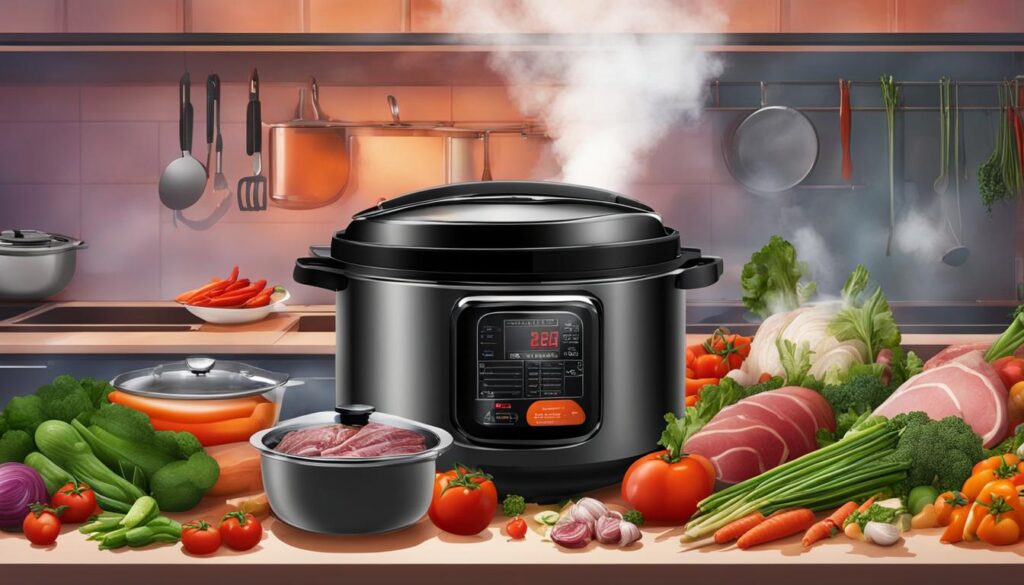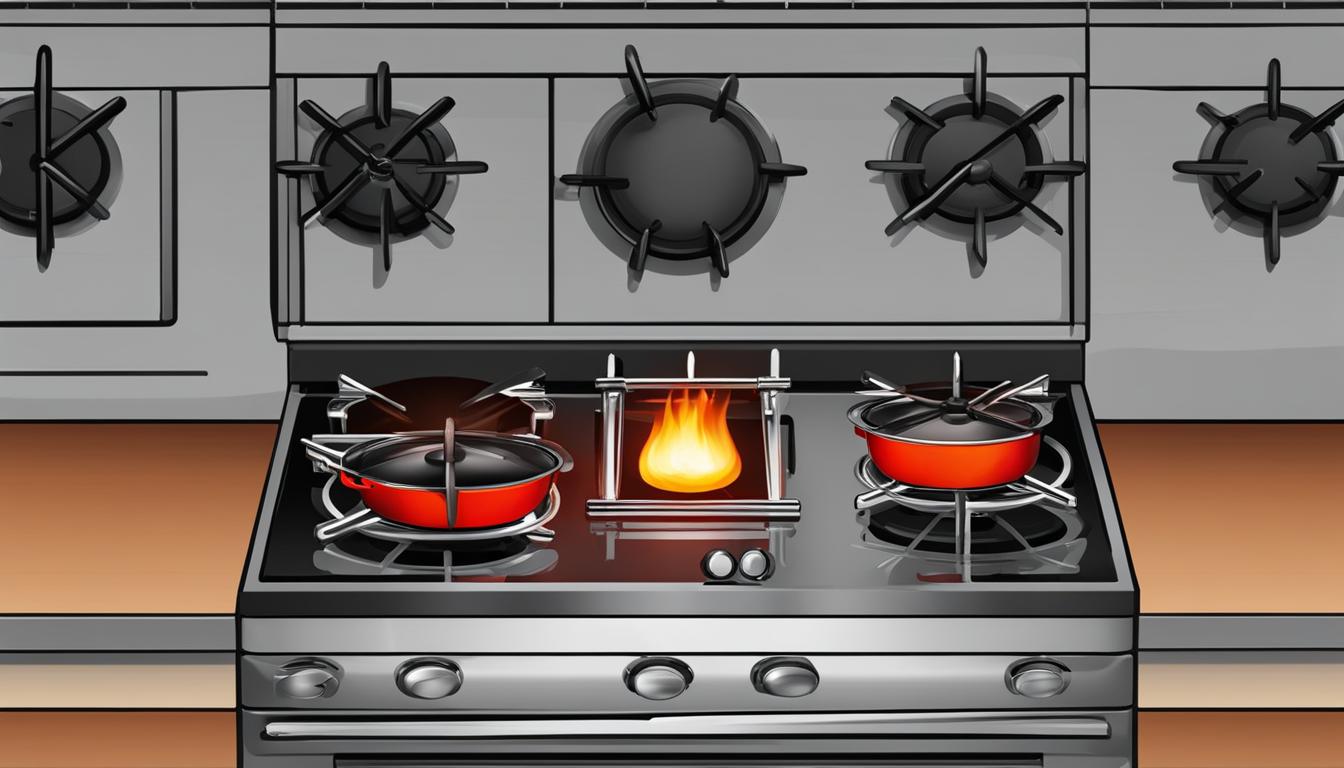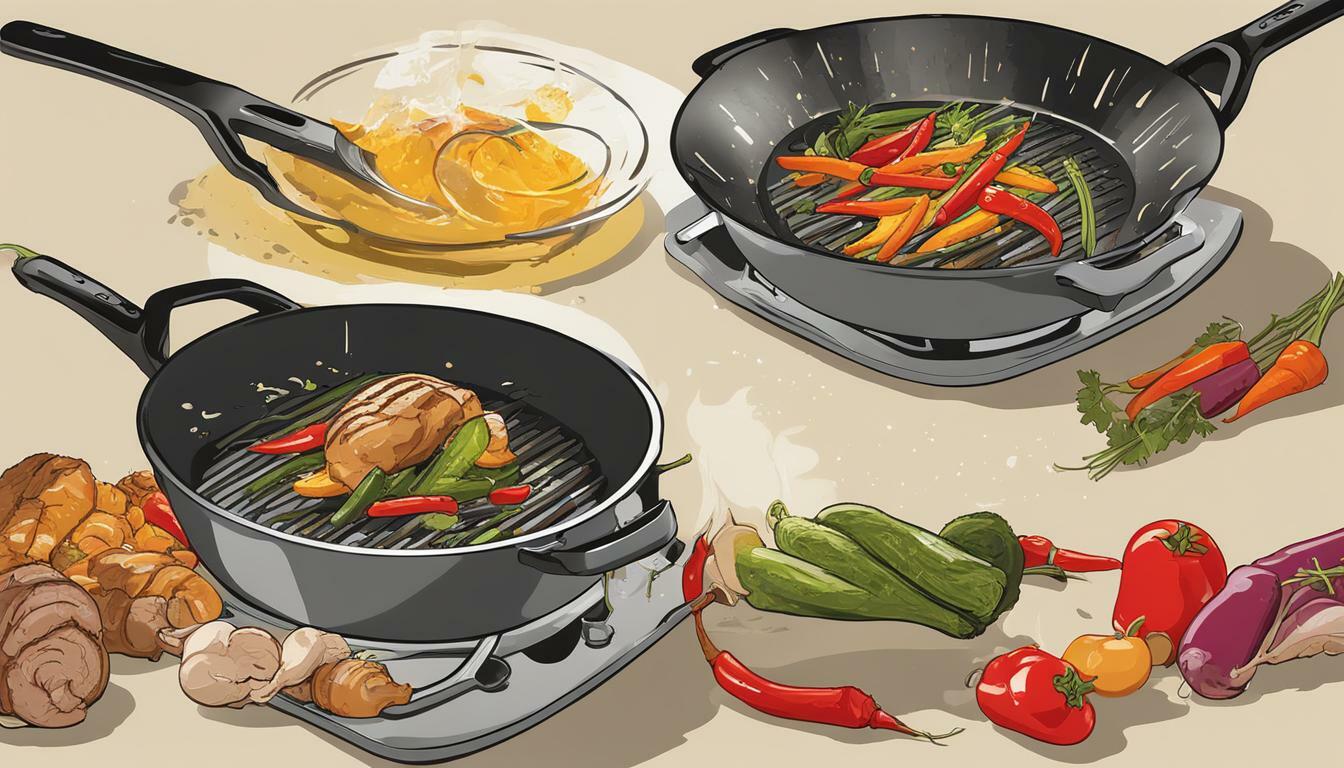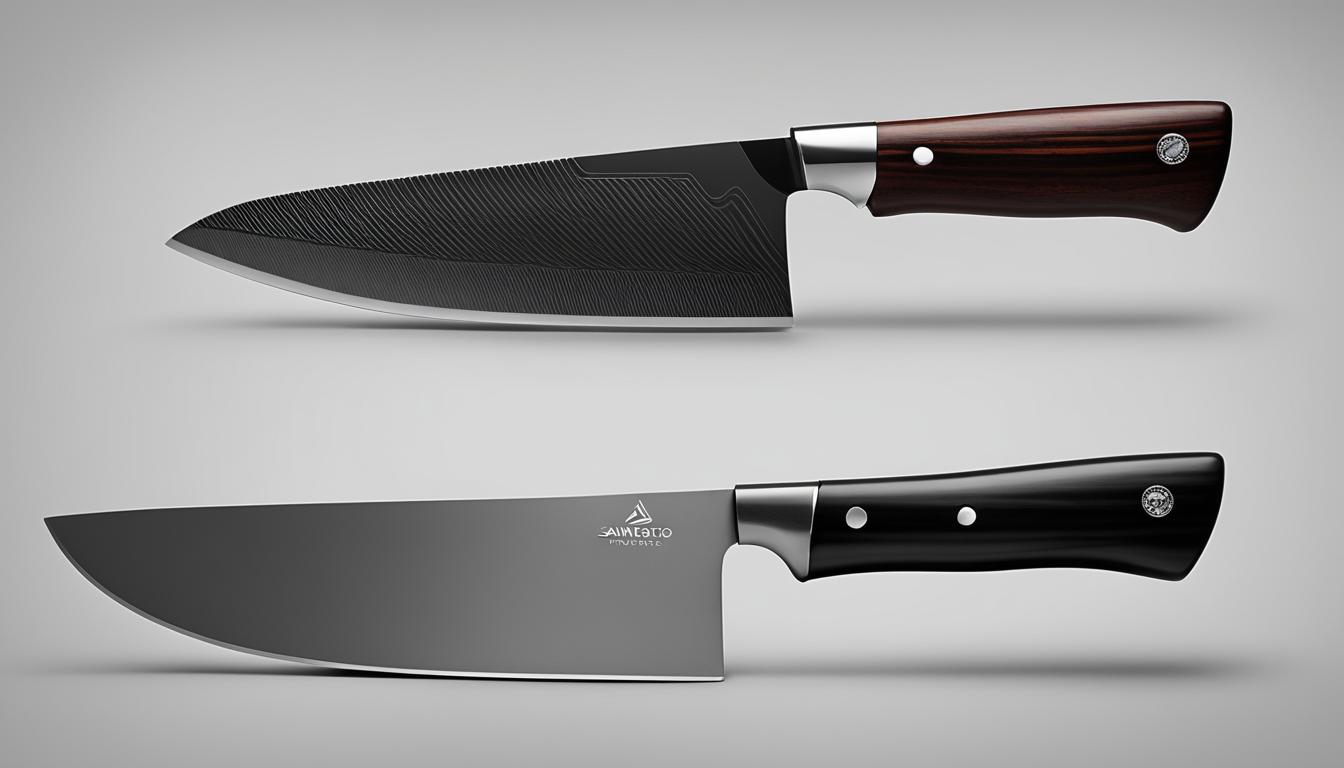When it comes to preparing meals, there are various cooking methods to choose from. Two popular methods that often come up in kitchen discussions are pressure cooking and slow cooking. While both techniques have their own unique advantages, they differ in terms of the cooking process and the outcomes they produce.
Key Takeaways:
- Pressure cooking uses hot steam and pressure to quickly cook food, while slow cooking employs low heat and longer cooking times.
- Benefits of pressure cooking include faster cooking times, nutrient retention, and tenderizing tough cuts of meat.
- Slow cooking offers convenience, enhanced flavors, and economical use of cheaper cuts of meat.
- Pressure cooking is ideal for time-crunched individuals and quick meat tenderization, while slow cooking is perfect for dishes that require longer cooking times and flavorful results.
- Ultimately, the choice between pressure cooking and slow cooking depends on specific needs, time constraints, and desired cooking outcomes.
Benefits of Pressure Cooking
Pressure cooking offers several benefits that make it a popular cooking method for many individuals. Here are some of the advantages of pressure cooking:
- Faster Cooking Times: One of the main benefits of pressure cooking is its ability to significantly reduce cooking times. The high pressure and steam created inside a pressure cooker allow food to cook more quickly compared to traditional methods. This makes pressure cooking ideal for busy individuals who want to prepare meals in a shorter amount of time.
- Retains Nutrients: Pressure cooking helps to preserve the nutrients in food. The shorter cooking times and minimal exposure to heat help to retain vitamins, minerals, and flavors that can otherwise be lost during prolonged cooking. This makes pressure cooking a healthier option for those who want to enjoy nutritious meals.
- Tenderizes Tough Cuts of Meat: Pressure cooking is particularly useful for cooking tough cuts of meat that require long cooking times to become tender. The combination of high pressure and moist heat helps to break down the connective tissues in meat, resulting in tender and flavorful dishes in a fraction of the time.
- Energy Efficient: Pressure cookers are energy efficient appliances. They require less time and energy compared to conventional cooking methods, such as stovetop or oven cooking. The sealed environment inside a pressure cooker allows for faster heat transfer and less heat loss, resulting in energy savings and reduced cooking time.
Overall, pressure cooking offers the advantage of faster cooking times, nutrient retention, tenderizing properties, and energy efficiency. It is a versatile cooking method that can be used to prepare a wide range of dishes, from soups and stews to grains and meats.
| Advantages of Pressure Cooking | |
|---|---|
| Faster cooking times | Save time in the kitchen |
| Retains nutrients | Preserves vitamins and minerals |
| Tenderizes tough cuts of meat | Quickly breaks down connective tissues |
| Energy efficient | Saves energy and reduces cooking time |
With its numerous benefits, pressure cooking is a valuable addition to any kitchen. Whether you’re looking to save time, retain nutrients, or tenderize tough cuts of meat, pressure cooking provides a convenient and efficient solution.

Benefits of Slow Cooking
Slow cooking offers a range of benefits that make it a popular cooking method for many households. One advantage is the convenience it provides. By preparing ingredients in the morning and allowing them to cook slowly throughout the day, you can come home to a delicious, ready-to-eat meal in the evening. This is especially beneficial for busy individuals or families with hectic schedules.
Another advantage of slow cooking is the enhanced flavors it brings to dishes. As the food cooks slowly over low heat, the flavors have time to develop, resulting in a more depth of taste. This is particularly beneficial for dishes like stews and soups, where the flavors need time to meld together.
Slow cooking is also a great way to tenderize cheaper cuts of meat. The long, slow cooking process helps to break down the connective tissues in the meat, resulting in tender and flavorful dishes. This not only allows for more economical meal options but also ensures that even tougher cuts of meat can be transformed into delicious and tender meals.
In addition to these benefits, slow cookers are energy-efficient and require minimal monitoring while cooking. They use low heat, which means less energy is consumed compared to using a conventional oven or stovetop. Slow cookers also have built-in timers and temperature controls, allowing you to set the desired cooking time and temperature and then leave it to cook without constant supervision.
Table: Comparing Pressure Cooking and Slow Cooking
| Benefits | Pressure Cooking | Slow Cooking |
|---|---|---|
| Speed of Cooking | Faster cooking times | Longer cooking times |
| Nutrient Retention | Retains nutrients in food | Preserves flavors and enhances taste |
| Tenderness of Meat | Tenderizes tough cuts of meat quickly | Tenderizes cheaper cuts of meat over time |
| Economy and Convenience | Energy-efficient and time-saving | Convenient and requires minimal monitoring |
Ideal Scenarios for Pressure Cooking and Slow Cooking
Pressure cooking and slow cooking each have their ideal scenarios where they excel in delivering delicious and convenient meals. Understanding these scenarios can help you determine which method is better suited for your specific cooking needs.
Pressure Cooking
Ideal scenarios for pressure cooking:
- When you need to cook a meal quickly
- For busy weeknights with limited time for meal preparation
- Cooking tough cuts of meat that require tenderizing
Pressure cooking is perfect for those situations where you’re short on time but still want to enjoy a flavorful and tender meal. The high pressure and steam in a pressure cooker allow for faster cooking times, making it an excellent choice for busy individuals or families. It’s also great for cooking tougher cuts of meat, as the high pressure helps break down the connective tissues, resulting in juicy and tender meat in a fraction of the time.
Slow Cooking
Ideal scenarios for slow cooking:
- Meals that require longer cooking times
- Convenience and hands-off cooking
- Tenderizing cheaper cuts of meat
Slow cooking is best suited for dishes that benefit from longer cooking times, such as stews, soups, and braised dishes. It’s a convenient cooking method that allows you to prepare the ingredients in the morning and come home to a perfectly cooked meal in the evening. Slow cooking also enhances the flavors of the food, resulting in rich, deep, and complex tastes. It is particularly effective for tenderizing cheaper cuts of meat, making them tender and flavorful.
| Pressure Cooking | Slow Cooking |
|---|---|
| Quick cooking times | Longer cooking times |
| Retains nutrients in food | Enhances flavors |
| Ideal for tough cuts of meat | Tenderizes cheaper cuts of meat |
| Energy efficient | Minimal monitoring required |
Which is Better: Pressure Cooking or Slow Cooking?
The choice between pressure cooking and slow cooking ultimately comes down to your specific needs and time constraints. If you’re looking for fast and convenient cooking, pressure cooking is the way to go. If you have the time and desire for longer cooking processes that enhance flavors, slow cooking is the ideal method. Both methods can be used to create delicious and satisfying meals, so it’s worth experimenting with both to find what works best for you.
Conclusion
After comparing the benefits and ideal scenarios of pressure cooking and slow cooking, it becomes clear that both methods have their advantages and are suitable for different situations. Pressure cooking offers fast cooking times and the ability to tenderize tough cuts of meat. This makes it perfect for busy individuals and those who want to quickly prepare a delicious meal. On the other hand, slow cooking provides convenience and enhances the flavors of the food, making it ideal for meals that require longer cooking times and cheaper cuts of meat.
In the ongoing debate of pressure cooking vs slow cooking, there is no definitive answer as to which method is better. The choice ultimately depends on your specific needs, time constraints, desired cooking outcomes, and personal preferences. If you need a meal ready quickly, pressure cooking is the way to go. If you want a meal that has been simmering all day and is bursting with flavor, slow cooking is the way to go. The good news is that both methods can be used to create delicious and satisfying meals that will leave your taste buds wanting more.
So, whether you prefer the efficiency of a pressure cooker or the convenience of a slow cooker, the takeaway is that both pressure cooking and slow cooking have their place in the kitchen. Experiment with both methods and discover the joys of creating meals with different flavors and textures. The final decision of pressure cooking or slow cooking is in your hands, and it all boils down to what suits your culinary style and preferences.
FAQ
What is the difference between pressure cooking and slow cooking?
Pressure cooking uses hot steam and pressure to quickly cook food, while slow cooking uses low heat and longer cooking times.
What are the benefits of pressure cooking?
Pressure cooking offers faster cooking times, retains more nutrients in the food, tenderizes tough cuts of meat, and is energy efficient.
What are the benefits of slow cooking?
Slow cooking is convenient, enhances flavors, tenderizes cheaper cuts of meat, and is energy-efficient with minimal monitoring.
When is pressure cooking ideal?
Pressure cooking is ideal for quick meals on busy weeknights and for tenderizing tough cuts of meat.
When is slow cooking ideal?
Slow cooking is ideal for meals that require longer cooking times, such as stews and soups, and for tenderizing cheaper cuts of meat.
 Skip to main content
Skip to main content


